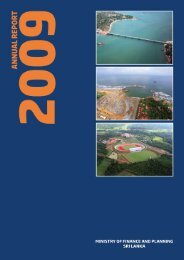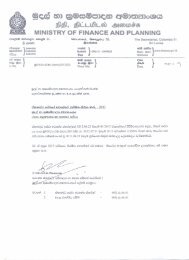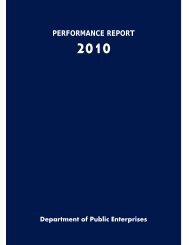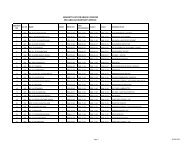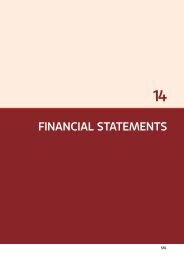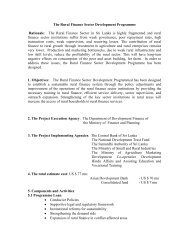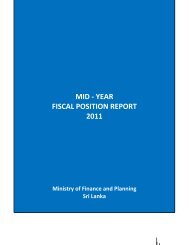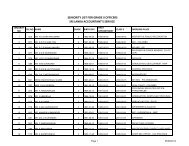Annual Report 2010 - Ministry of Finance and Planning
Annual Report 2010 - Ministry of Finance and Planning
Annual Report 2010 - Ministry of Finance and Planning
You also want an ePaper? Increase the reach of your titles
YUMPU automatically turns print PDFs into web optimized ePapers that Google loves.
3 | REFORM INITIATIVESOverview<strong>2010</strong> - 2011 End MayHaving ended the long drawnconflict, the Governmentfocused on promoting publicinvestment in strategic industries, <strong>and</strong>consolidating reforms in several areasto create an enabling environmentfor accelerated growth. Reforms werewitnessed in areas including taxation,banking <strong>and</strong> finance, investment,governance <strong>and</strong> accountability, socialsecurity, institutional reorganization<strong>and</strong> public procurement.The consultation process associatedwith the following, providing theGovernment with greater insightinto stakeholder views required tobe recognized in the developmentprocess.• Inputs received fromrepresentatives at national,provincial <strong>and</strong> local governmentlevels, during the isl<strong>and</strong> wideconsultation process carried outby His Excellency the President ineach Provincial Council area, witha view to identifying need basedprovincial development concerns.• Inputs received in the process <strong>of</strong>the continuous dialogue betweenHis Excellency the President withrepresentatives <strong>of</strong> trade unions,trade <strong>and</strong> industry chambers,pr<strong>of</strong>essionals, the businesscommunity, the SMEs <strong>and</strong> selfemploymentassociations <strong>and</strong> theinformal sector representatives,adopting a need based approachtowards economic reforms.• The outcome <strong>of</strong> the dialoguebetween the <strong>Ministry</strong> <strong>of</strong> <strong>Finance</strong><strong>and</strong> <strong>Planning</strong> <strong>and</strong> the members<strong>of</strong> the Sectoral Clusters, pavingway for tax payers as well asother stakeholders in the process<strong>of</strong> development to give aninsight to their practical needs<strong>and</strong> the obstacles, enabling thegovernment to formulate policywith greater awareness <strong>of</strong> theground realities.• The Final <strong>Report</strong> <strong>of</strong> the 10 memberPresidential Commission onTaxation that was appointed inJuly 2009 as envisaged in theBudget Speech 2009, which wassubmitted in October <strong>2010</strong> havinghad extensive consultations, alsogave valuable recommendationson the desired changes <strong>and</strong>reforms.• The Final <strong>Report</strong> <strong>of</strong> the fivemember Ministerial Sub -Committee appointed in May<strong>2010</strong>, assisted by a panel <strong>of</strong> PublicOfficials with diverse expertise,to identify Impediments toInvestment submitted its reportin November <strong>2010</strong>, identifyingsuch impediments <strong>and</strong> suggestingpossible remedial measures.This report has been preparedafter extensive discussions withinvestors, businessmen, private<strong>and</strong> public sector <strong>of</strong>ficials,representatives <strong>of</strong> trade chambers<strong>and</strong> lawyers <strong>and</strong> hence gave avivid view <strong>of</strong> related concerns.Stemming from these insights <strong>and</strong>recognizing the global <strong>and</strong> regionalchallenges faced by the country, areform package with emphasis ontaxation was introduced through the2011 Budget. The other reforms signifysystem improvement endeavours bythe government, involving institutional,administrative <strong>and</strong> procedural relatedadvances.The reform agenda recognizedbuilding Sri Lanka’s economic futureon five, well connected pillars involvingport, shipping, aviation, energy,commerce <strong>and</strong> knowledge. Growthstrategies linked to such a ’hubbased’ development, placed emphasison promoting investment to reapthe peace dividend by developingvalue added manufacturing <strong>and</strong>services. Tourism was promoted inthe backdrop <strong>of</strong> the internationalpublicity portraying Sri Lanka as one<strong>of</strong> the preferred eco-friendly touristdestinations with unique bio diversity.Agriculture was incentivized throughmany measures including a fertilizersubsidy <strong>and</strong> guaranteed producerprices to ensure food security. Small<strong>and</strong> Medium Enterprises (SMEs)received priority treatment to exploittheir vast <strong>and</strong> untapped potential.Tax ReformsIn the area <strong>of</strong> tax reforms, the st<strong>and</strong>ardcorporate tax rate was reduced from35 percent to 28 percent <strong>and</strong> thecapital consumption allowance wasincreased to make the system moreinvestor friendly. The threshold forthe chargeability <strong>of</strong> the EconomicService Charge was increased from Rs.7.5 million to Rs. 25 million a quarter,mainly for the benefit <strong>of</strong> the SMEs.In the case <strong>of</strong> individuals, themaximum income tax rate was reducedfrom 35 percent to 24 percent. The taxslabs were broadened. Tax on certainterminal benefits was removed, whilechargeability <strong>of</strong> tax on certain otherretirement benefits was also reduced.Further, in relation to those whoseonly source <strong>of</strong> income is employment,the need to file income tax returnswas removed by making PAYE as atax at source. Provisions were madeto permit the submission <strong>of</strong> quarterlyreturns for VAT while having tomake monthly payments, to simplifycompliance.The Nation Building Tax (NBT) isalso simplified <strong>and</strong> extended up tothe wholesale <strong>and</strong> retail level byamalgamating the provincial turnovertax relating to those sectors, withthe introduction <strong>of</strong> a system in which174





